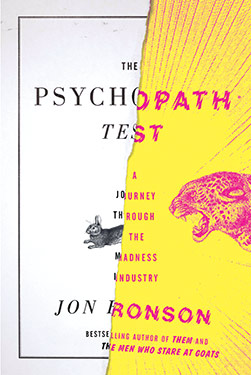Reading Between The Lines: They're everywhere: The Psychopath Test
 CREDIT: RIVERHEAD BOOKS
CREDIT: RIVERHEAD BOOKSIn author Jon Ronson's The Psychpath Test: A Journey Through the Madness Industry, readers explore the world of psychopathy through interviews with industry professionals.
Jeffery Dahmer, Ed Gein. Buffalo Bill, Norman Bates.
It’s almost easy to name psychopaths, real and fictional. You’re no psychologist, but you feel like you’ve had enough exposure to the concept of a psychopath through these characters. After all, what are they really? Remorseless killers and nothing more, right?
The study of just what psychopathy is has been a long journey that began from the early ‘60s and continues to this very day, and is very fascinatingly covered in The Psychopath Test: A Journey Through the Madness Industry.
Written by Jon Ronson – author of The Men Who Stare at Goats fame – The Psychopath Test continues his dive into the strange and unusual, deconstructing what popular culture defines textbook psychopathy. Although not as lurid as The Men Who Stare at Goats and the movie loosely inspired by it, The Psychopath Test still serves well as a jumping off point for those who want to further study this mental state we are both frightfully fascinated as well as morbidly in admiration of.
Tony – a pseudonym – has lived in Broadmoor Hospital, Berkshire, England, since his late teens. After several run-ins with the law, he claims to have tried to worm his way out of a prison sentence by getting diagnosed with criminal psychopathy, learning how to exhibit the symptoms by watching Psycho and Silence of the Lambs.
Instead of serving a stint of a year or so in a comfortable psychiatric ward, he’s spent about 20 years in Broadmoor, home to some of the more notorious serial killers and butchers over the years, all the while claiming he’s perfectly sane. But isn’t that what all psychopaths think of themselves?
From that jumping-off point, enter Bob Hare – one of the key pioneers in the study of psychopathy and creator of the Psychopath Checklist, a list of criteria that defines someone as a likely candidate for the condition. The history of psychopathy is a history of modern psychiatric medicine, and everything from the earliest, bizarre experimental treatments of mental conditions with LSD, to the creation of the DSM-IV, the modern Grey’s Anatomy for psychologists, is covered in fascinating detail.
After interviewing Hare and attending his seminars, Ronson then branches out to interviewing warlords and corporate CEOs who gleefully led mass layoffs, diagnosing them as potential psychopaths. Whether or not you agree with Ronson, it becomes abundantly clear soon enough that psychopaths are less axe-wielding madmen and more demons in suits.
Staying balanced, the book also touches upon psychiatry and psychology’s detractors, from keen Scientologists to New Age spiritualists. The Psychopath Test discourages the use and abuse of Hare’s methods, with Ronson detailing his own follies as a word of caution.
Despite some breaks in the flow with Ronson’s occasional author tracts, it’s never invasive enough to destroy any potential interest the reader might have in seeking out more literature about psychopathy, and the larger study of the human mind in general.













